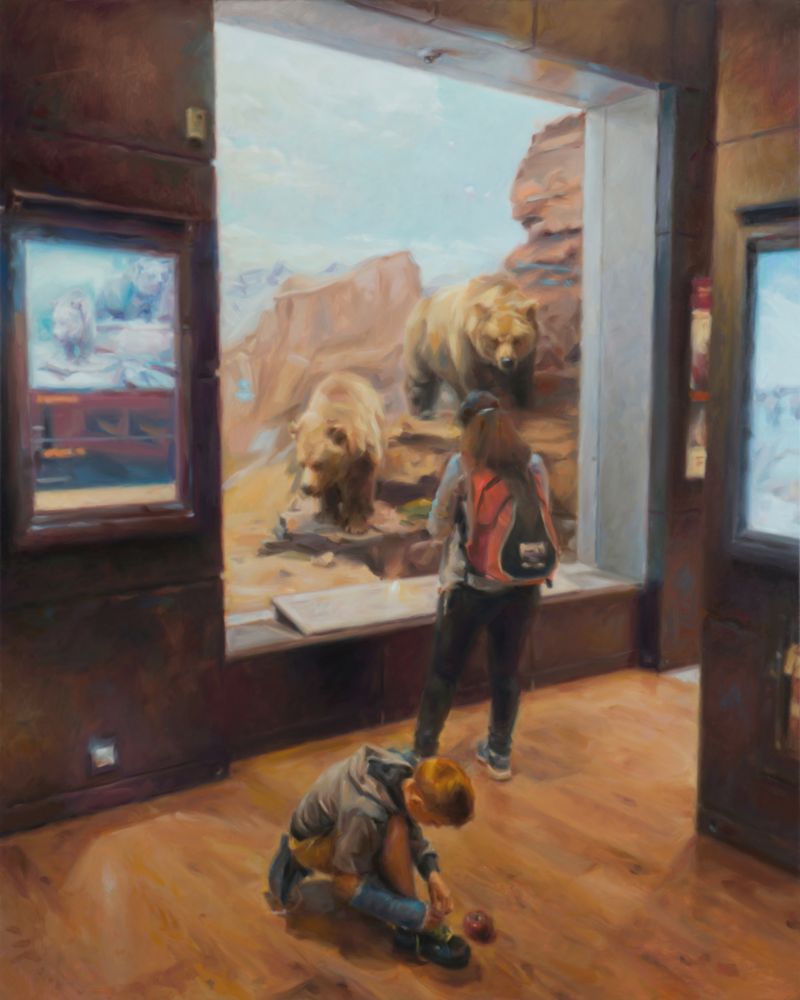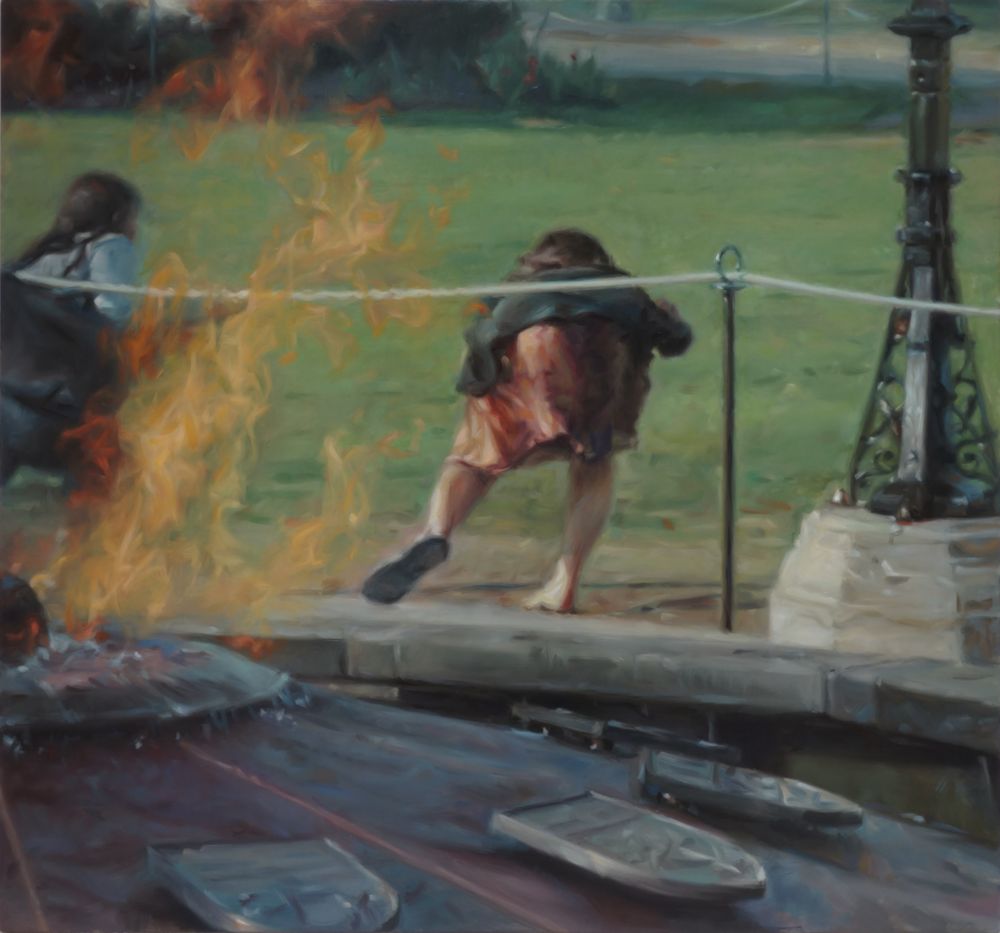STEVEN VOLPE
Behind the Magic Curtain
bio
I paint open-ended narratives derived from unremarkable scenes: ordinary people engaged in ordinary activities. Achieving an effect that is out of the ordinary is where the work begins: the transforming, the editing, the re-imagining. Positioned somewhere between a detached eyewitness account and a symbol-laden parable, my paintings invite interpretation yet still retain a comfortable and coherent plausibility.
In 2016, I received the Ontario Arts Foundation Laura Ciruls Painting Award—the accolade that has meant the most to me, so far. My home and studio are located in Orangeville, Ontario where I live with my wife, Wendy.

Natural History
36″ x 30″, Oil on Canvas

Balzac's Café, 32.5" x 36.75", Oil on Canvas
There is a classical and scholarly air to the man featured in Balzac’s Café. His counterpart in this late afternoon standoff consists of a tower of books: old volumes that are yellowed and worn, dog-eared and marked, with one paperback revealing an open fan of pages and acting every bit the lively participant in this conversation. The man’s gestures in mid-exchange are contradictory: the slight smile and open hand are at odds with the concealed hand that statically, almost ominously, holds a lighter in place as the flame burns just beneath the table. Tension between paper and fire is evident, with nearby greenery withering in the arid atmosphere, accentuating the potential of the flame. Although I had no specific literary reference point in mind, I wanted the open-ended narrative to have the feel of a modern-day adaptation of a myth or parable, prompting interpretations related to knowledge, discourse, opinion, and ideology.

Balzac's Café - Early Version
I wasn’t happy with how the right side or the top of the composition were progressing, and I felt that a larger area of brightness would remedy the mid-tone dominance. So, I re-stretched the canvas on a smaller stretcher frame, and renovated the café by taking down the wall. The sky provided an opportunity to include supportive elements like the smoke and street lights. I was happy with the final version, but looking back, I think I could have made the early version work.

Namesake, 24″ x 20″, Oil on Canvas

Namesake - Reference
I often use myself as a reference for specific poses, and, of course, I include myself in my paintings. As models go, I’m always on hand and usually compliant. In this photo, I was studying how the shadow of my figure would appear on the ground and on a vertical plane. In the final version of the painting, I opted for a different variation of the shadow, but the photograph gives an idea of how I improvise with objects around the house and in the garage.

Street Performer, 48" x 36", Oil on Canvas
The puppeteer, typically engaged in an exercise of finesse and fine motor skills, here is managing a cumbersome load as he lumbers along a dirty sidewalk. Two precariously-placed marionettes appear to be animated by the effects of gravity and motion, and in a reversal of order, the puppets appear to be the ones exerting control over the proceedings. The man becomes entangled by the strings, some of which have broken, and the cross-shaped controller hangs in front of his face in a taunting, unattainable fashion. The inclusion of the clown puppet, a memory from my childhood, was important to me in illustrating the idea of how nostalgia can be both a source of inspiration as well as a kind of limiting enslavement.

Street Performer - Reference
This is a photo of the clown puppet that I wanted to include in Street Performer. Teto the clown, a marionette that I remember from my childhood, has been gone for years, so I tracked down some images online to help me recreate the reclining pose. I even thought about ordering the actual puppet (for both sentimental and practical reasons), but he’s vintage and doesn’t come that cheap.

Legacy, 43" x 33", Oil on Canvas
Legacy features French Canadian figurative painter, Jean Paul Lemieux, in two representations within one scene: as an existing monument to the famous artist, and as a maintenance worker carefully applying paint to the facade of a building. The artist—or more humbly stated ‘the painter’—toils in the puddles and shadows in a very workmanlike fashion. An old factory on the left side of the painting reinforces the idea of churning artistic production, and the dog in the foreground serves as a link between the two versions of Lemieux, tethered to the monument while attentively watching the “artist” at work. I took some liberties with the locale where the monument stands in Old Quebec, removing the far wall of the actual courtyard to reveal an imaginary landscape beyond a glass railing. This was a way of taking the painting out of the realm of the literal, since there is a surreal element to having an artist appear in the same scene with the posthumous statue erected in his honour.

Legacy - Reference
My wife, Wendy, and I were in Creemore at the Horse, Hound and Harvest Parade in October of 2018. At one point, spectators were permitted to mingle with the riders and pet the hounds. I took a lot of photos that day, not knowing where or how one of the dogs would end up in one of my paintings. I used this photo for the body of the dog, and another photo for the head. For the shadows on the ground, I created a crude plasticine model and lit it with a flashlight.


Counterfeiter, 22″ x 30″, Oil on Canvas
Because the underlying image of this composition was derived from Christ Crucified by Velazquez, the title, Counterfeiter, was intended as a tongue-in-cheek reference to the idea of the student copying the master. The tape measure and paint swatches were included not only for narrative and symbolic purpose alone, but also to offset the psychological weight of the ominously-lit arrangement of hands, shadows, and dark voids. While measuring and colour-matching do account for a significant part of the execution of a painting for me, my hope was that this painting would tap into some deeper ideas through a stark—even grimly humorous—contrast of imagery: intense biblical drama serving as a backdrop for mundane symbols of modern interior design.
Counterfeiter – Sketch
For Counterfeiter, I had an idea of what elements I wanted in the painting, and the thumbnail sketches were my very first attempts at visualizing how the composition might look. The only sketch that includes the camera is the one at middle-left, where I had considered making the painting out of three separate square panels.
Nursery Rhyme,
45″ x 36″, Oil on Canvas


Vigil,
40″ x 32″, Oil on Canvas
Striding with purpose and impossibly overlapping steps, the two people in Vigil almost walk through one another. Like many people on the move in the city streets and sidewalks, they are in close contact yet psychologically isolated. Although the candles they hold—with anemic, soon-to-be-extinguished flames—are open to interpretation, one thing is clear: This is not a static, communal vigil but rather something of a divided, individual, and personal nature. I was also thinking of the candles as symbolic surrogates for cell phones which could be regarded as handheld sources of light. The aerial perspective puts the viewer in a position of surveillance, a kind if vigil itself. Looking more closely, we can see how the linear shadows cast by the figures radiate at different angles than those mimicked by the candlesticks. This small detail, in addition to the odd proximity of the two people, contributes to the effect of time lapse.

Parliament Hill, 30″ x 32″, Oil on Canvas
Parliament Hill – The Earlier Version
Parliament Hill began its life on a much taller canvas stretcher. The composition lacked focus with too many figures vying for attention. I re-stretched the canvas on a smaller frame, raising the two girls and the foreground monument up about two or three inches, while lowering the distant tree line. After painting a few versions of the handbag seen in front of the central figure, I decided to get rid of it all together.

Union Station, 36″ x 45″, Oil on Canvas
The yellow safety lines of a train platform are both the structural and interpretive armature for this composition. Standing aloof and defiantly unfazed by the oncoming train, the central couple is surrounded by, or accompanied by, an open circle of pylons. The ambiguous symbolism of this grouping is what spurred me on to create Union Station. The newspaper and coffee cup on the track appear to have an animated presence, and were intended to feel narratively linked to the couple. Themes of caution, deliberation, and direction are evident, and the peripheral figures play their roles: The woman on the far left—the only one in obvious motion—walks vulnerably along a prohibitive zone, and the remaining three on the right side of the painting seem more contemplative than purposeful in their body language. Technically, this painting was a bit of a departure for me: I opted for less refinement in the execution, retaining much of the thin gestural underpainting; also, I pushed the contrast between the cool natural ambience and the warm artificial lighting to establish a mood of heightened sensations.


Skywriter, 36" x 42", Oil on Canvas
A rooftop has served as a setting for three of my paintings, to this point. All three compositions feature satellite dishes and vents, an entanglement of wires and antennae, and billowing smoke—elements elevated to almost poetic status. In Skywriter, the most whimsical of the three variations, I have depicted the artist, myself, standing at my easel atop a dilapidated and graffiti-ridden rooftop structure operating two remote control planes. The planes leave behind trails of smoke that intermingle with actual contrails and clouds forming a kind of atmospheric calligraphy. The painting feels dreamlike to me, both in theme and rendering. There seems to be a perception of scale that fluctuates much as it would within a dream. The odd tension between ‘the model’ and ‘the real thing’ is definitely present here, not only with respect to the airplanes, but through the fractal-like repetition of a canvas within a canvas.
For more information and to further explore Steven Volpe’s work, please contact Rodrigues Contemporary
